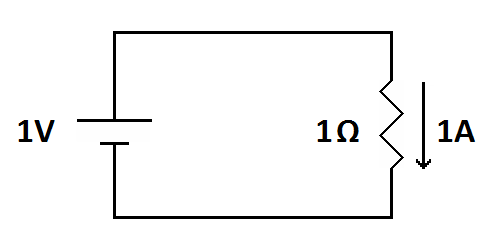| Vocademy |
What is Power
Whenever electrical current flows through a resistance power is
produced. In electronics, power production is usually manifested by the
production of mechanical motion (often in the form of sound waves),
heat (which is actually mechanical motion of atoms) or electromagnetic
radiation (radio waves, light, x-rays or gamma rays). If none of these
are produced, even if you are able to calculate a quantity of power, no
power is produced. The following diagram shows the basic relationship
of power in a circuit.

| In this circuit, one watt is being produced (1 volt times 1 ampere, 1 X 1 = 1) |
Power is the product of current and voltage. If you multiply the
voltage across a resistor by the current passing through it, you will
get the power produced in Watts.
Power = Voltage times Current
Therefore:
P = E I
Where:
P = power in watts
E = electromotive force in volts
I = current in amperes
E = electromotive force in volts
I = current in amperes
If you don't know the voltage, but you do know the resistance, there is
another formula. We already know that voltage can be calculated with
Ohm's Law:
E = I R
Therefore, if power is the product of current and voltage, and voltage
is the product of current and resistance, then power is the product of
two times the current and resistance:
P = I E
and:
E = I R
therefore:
P = I x ( I x R )
which is the same as:
P = I x I x R
Therefore, power can also be calculated with the following formula:
P = I2 R
What if you know the voltage but don't know the current? We already know that current can be calculated with Ohm's Law:

Therefore, power can be calculated as follows.
| |
 |
or |
 |
This gives us three different formulas for calculating power,
depending on what quantities you already have. These formulas
are:
Calculating Power:
| ● |
P = I E |
(voltage times current) |
| ● |
P = I2 R | (current squared, times resistance) |
| ● |
 |
(voltage squared, divided by resistance) |
Where:
P = power in watts
E = electromotive force in volts
I = current in amperes
R = resistance in ohms
E = electromotive force in volts
I = current in amperes
R = resistance in ohms
Power is cumulative
If you have several components or subcircuits consuming power, each contributes to the total power consumed by the circuit. Let's say you have a circuit powered by a 10-volt battery and there are a total of two amps in the circuit. This tells you that the total power produced by the circuit is 20 watts. There may be places in the circuit where there is a product of voltage and current without the production of power. However, the supply (battery) voltage and the total current tells you the total power produced by the circuit.
Exercises:
Power calculations:1
- A circuit has a current meter that is measuring 2.5 amperes. The voltage across a resistor in the circuit is 5 volts. What is the power being produced in the resistor? ___________
- A circuit has a current meter that is measuring 3 amperes. A resistor in the circuit is labeled as 5 ohms. What is the power being produced in the resistor? ___________
- A resistor has 4 volts across it. The resistor is labeled as 2 ohms. What is the power being produced in the resistor? __________
- A circuit has a current meter that is measuring 100 milliamperes. A resistor in the circuit is labeled as 1,000 ohms. What is the power being produced in the resistor? ___________
- A 12-volt battery is powering a circuit (providing the total voltage for the circuit). A current meter shows that 45 milliamps are flowing through the circuit (the total current for the circuit). What is the total power being dissipated by the circuit? _______________
In AC circuits you may come across the term voltampere (voltamp) or VA.
This implies that power is being produced because power is the product
of voltage and current. However, in some devices, you can have voltage
and current, but no power is actually produced (no heat, motion or
electromagnetic waves are produced). In such cases, the term power is
inappropriate, so the term voltampere is used instead. Also in AC
circuits, the voltage and current are often out of phase with each
other (continually changing but not at the same time). Voltmeters and
current meters cannot keep up with the constant changing with AC
circuits, so they show a value that resembles an average. In this case,
the actual power is less than the product of the voltage and current as
shown on the meters. The product of the voltage and current where the
voltage and current are out-of-phase is called the apparent power.
Summary:
Power
- Power is the product of voltage and current.2
- Power is not produced if neither heat, electromagnetic waves or motion are produced. In such cases, the product of voltage and current is called voltamperes (VA)
- When voltage and current are out-of-phase, as they may be in AC circuits, the product of voltage and current is called apparent power.
- The total power consumed by a circuit is the source voltage multiplied by the total current.
What is Power
| 1 |
1) 12.5 W; 2) 45 W; 3) 8 W; 4) 10 W; 5) 540 mW (0.54 W) |
| 2 | In reality,
power is the product of current (squared) and resistance. Multiplying
voltage by current often gives a false value called apparent power.
More about that under AC circuits. |
| Vocademy |